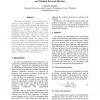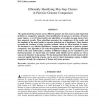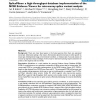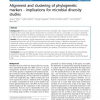13 search results - page 2 / 3 » Combining diverse evidence for gene recognition in completel... |
CSB
2005
IEEE
13 years 12 months ago
2005
IEEE
Traditional phylogenetic tree reconstruction is based on point mutations of a single gene. This approach is hardly suitable for genomes whose genes are almost identical and hardly...
BMCBI
2005
13 years 6 months ago
2005
Background: Complete sequencing of bacterial genomes has become a common technique of present day microbiology. Thereafter, data mining in the complete sequence is an essential st...
JCB
2008
13 years 6 months ago
2008
The spatial clustering of genes across different genomes has been used to study important problems in comparative genomics, from identification of operons to detection of homologo...
BMCBI
2007
13 years 5 months ago
2007
Background: There are many fewer genes in the human genome than there are expressed transcripts. Alternative splicing is the reason. Alternatively spliced transcripts are often sp...
BMCBI
2010
13 years 6 months ago
2010
Background: Molecular studies of microbial diversity have provided many insights into the bacterial communities inhabiting the human body and the environment. A common first step ...




